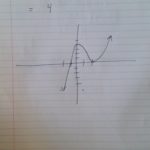
Break out your compass, ruler and colorful pens. Here's the cliff notes version of constructing a 9 point circle by hand. 1.Draw a scalene triangle and construct midpoints. These are done by putting the sharp end of the compass on a vertex and extending the pencil slightly more than half the estimated distance along that segment of the triangle. Draw an arc and do it the same from the other end of the segment. Repeat for the other two sides. 2. Draw altitudes. Put sharp end of compass at a ver...
More




